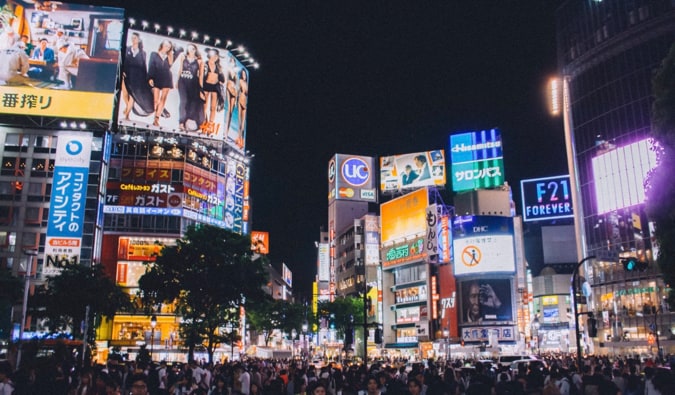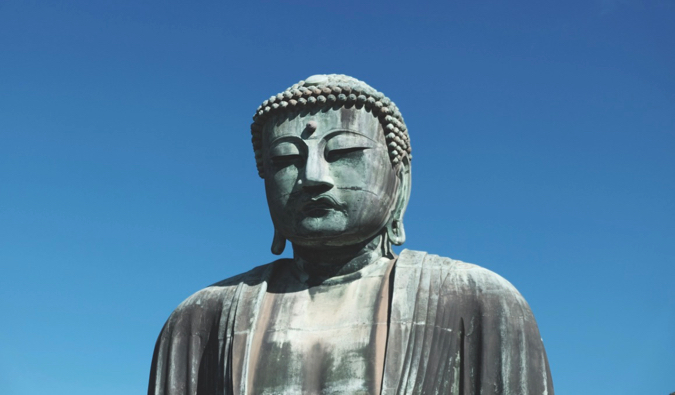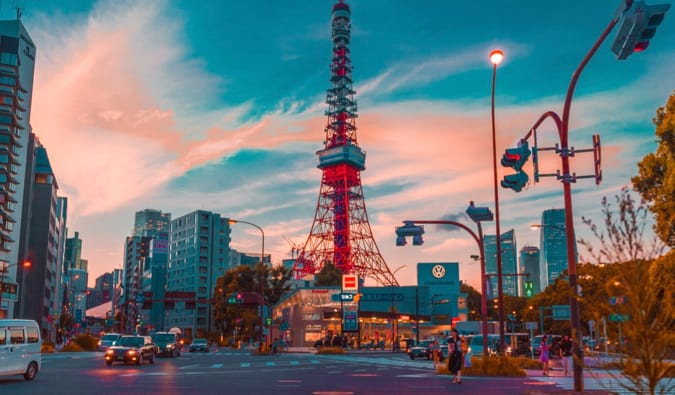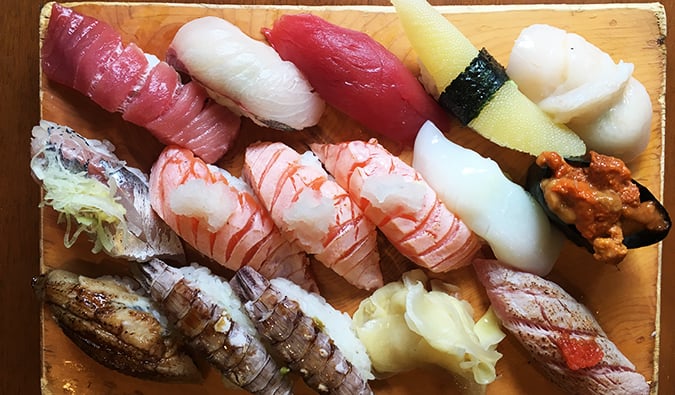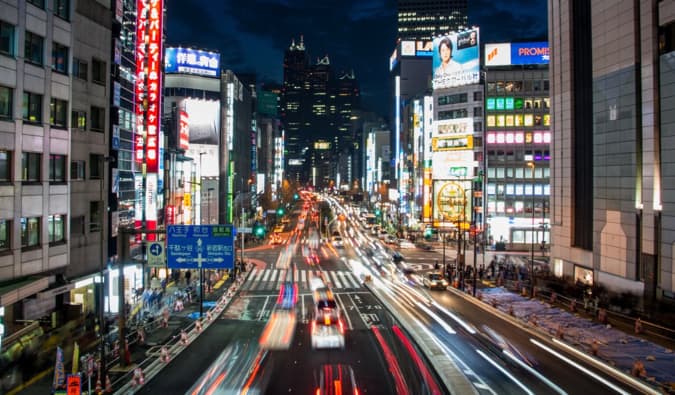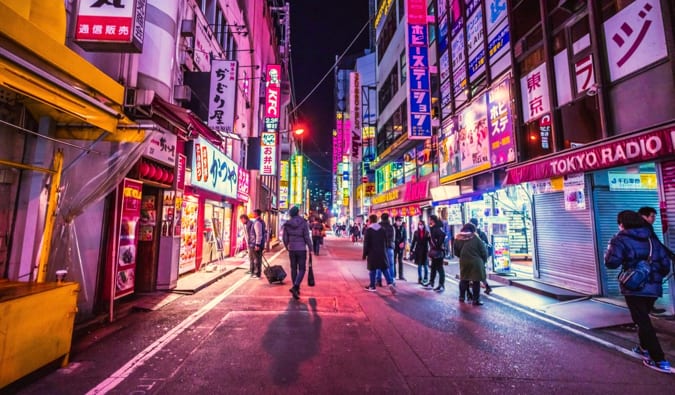
Posted: 5/18/2019 | May 18th, 2019
Tokyo is one of the most expensive cities in the world.
But there are still amazing and affordable hostels in Tokyo where you can stay and lower your costs!
Like Tokyo itself, the hostels here are clean, arty, and have lots of charm. A lot of them are super trendy with beautiful décor. Wi-Fi is standard, and many will have cooking facilities too. Beds generally cost between 2,000 and 5,000 JPY ($18-45 USD) per night. They host events, serve a ton of tea, and have little cubbies you can sleep in.
Whether you’re looking for a relaxing stay or to party the night away, the city has something for everyone!
Tokyo does hostels right!
To help you plan your trip, here is my list of 13 hostels in Tokyo that I like the most.
1. Khaosan Tokyo Origami

This hostel is in Asakusa and only a five-minute walk to Senso-ji Temple and the Asakusa station. The hostel is clean and there’s air-conditioning. The rooms are pretty spacious, which is uncommon in most Tokyo hostels. The beds are comfy and cozy, and there are privacy curtains.
There’s also a nice common lounge with free coffee and tea, and you can use the kitchen 24/7. You’ll also enjoy some extra comforts, such as the slippers they provide, and the free, simple breakfast of toast and coffee/tea. The lounge on the eighth floor is a great place to hang out, play video games, and take in the views over Tokyo!
Beds from JP¥ 3,200/$29 USD, privates from JP¥ 8,800/$80 USD.
—> Book your stay at Khaosan Tokyo Origami
2. Sheena and Ippei
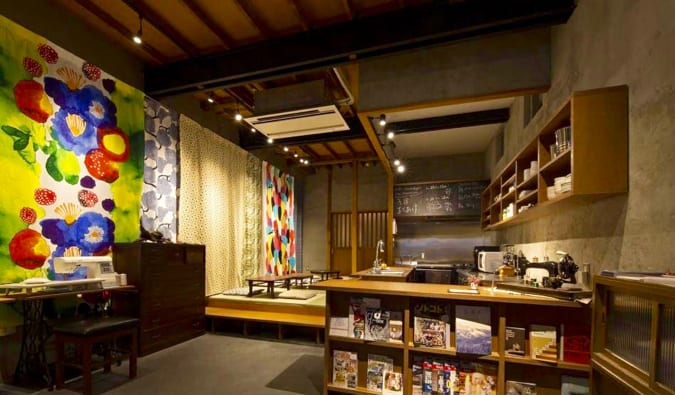
Sheena and Ippei is a small hostel located in downtown Tokyo, near the Ikebukuro station. The décor here is quite unique, as the owners have used beautiful Japanese fabrics to line the walls. The place is very homey, and the staff are really helpful when it comes to suggesting things to do around the area. There is no kitchen, but you can use the microwave and refrigerator.
The first floor is actually home to a café equipped with sewing machines that customers can use (local people make handicrafts and hold events here every week). It turns into a hostel lounge in the evenings, and you can have appetizers and sake on the weekends.
Beds from JP¥ 4,104/$37 USD, privates from JP¥ 15,120/$138 USD.
—> Book your stay at Sheena and Ippei
3. Hostel Chapter Two Tokyo
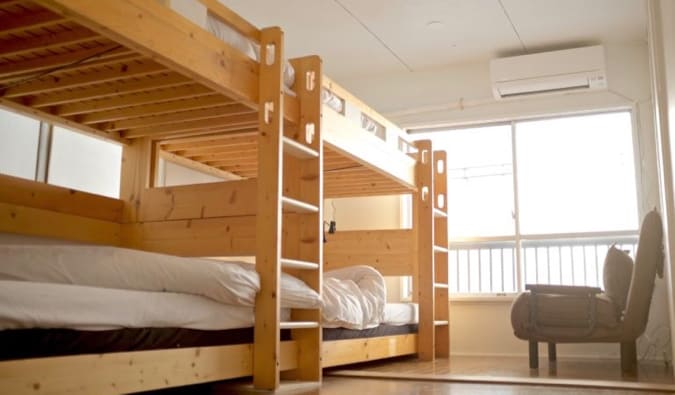
Chapter Two is a small, family-run hostel not far from Skytree Station in Asakusa. I really like the shared kitchen and common room, as there’s a real social feel to it. The dorms are modern, immaculate, and nicely equipped. You can book a deluxe pod, which gives you a partitioned-off bed with a privacy curtain, which is a nice change from the open-concept dorm.
There’s also a great view of the Sumida River — try to get a bed facing it! The rooftop patio comes with a co-working area, and it’s a terrific option for relaxing and hanging out. The owner is super friendly!
Beds from JP¥ 3,900/$36 USD, privates from JP¥ 9,200/$84 USD.
—> Book your stay at Hostel Chapter Two Tokyo
4. Khaosan Tokyo Kabuki

This hostel’s location in Asakusa is stellar: just a one-minute walk to Kaminarimon (the gates to Senso-ji), Asakusa Temple, and the Asakusa station. The rooms are a little dull, but they are comfy and clean, and all have en suite bathrooms. Try to get a room upstairs so you’re not right next to the common room (which can get rowdy at night). If you can get a view of the Skytree Tower, you’re in luck!
The common kitchen offers free coffee and tea, plus you get free shampoo and conditioner. The staff is really nice, and they have takoyaki (snack) parties where you can learn all about Japanese culture and nightlife.
Beds from JP¥ 2,700/$25 USD, privates from JP¥ 1,2750/$116 USD.
—> Book your stay at Khaosan Tokyo Kabuki
5. Hostel Bedgasm

Located in East Tokyo, Hostel Bedgasm has a lively bar, and guests get a free drink every night. It’s a small gesture, but it’s a great way to meet other travelers and to socialize. The bathrooms are clean, and there’s a common kitchen and a quiet rooftop patio area. There’s plenty of storage for your items, and the staff is very helpful!
The neighborhood is not too noisy and has great food options — especially the nearby ramen place and bakery (the staff will point you in the right direction). You can get to Ueno, Ginza, Roppongi, and the Tsukiji fish market direct by metro from here.
Beds from JP¥ 3,500/$32 USD, privates from JP¥ 8,500/$77 USD.
—> Book your stay at Hostel Bedgasm
6. Kaisu Hostel

Kaisu used to be a ryotei, a traditional Japanese restaurant with performing geishas. The building has kept a lot of its original architecture, like tatami-style private rooms with large windows and a high ceiling; the dorms have bunk beds with curtains for more privacy. This hostel is a bit more expensive, but it feels more like a hotel than a hostel and is spotless. It’s not a party place, but you can meet a lot of fellow travelers at the café.
Plus, guests get two free shots of sake on Tuesdays, and free breakfast every morning! Roppongi, Aoyama, and the National Art Center are within walking distance.
Beds from JP¥ 4,300/$39 USD.
—> Book your stay at Kaisu Hostel
7. Backpackers Hostel K’s House Tokyo

This hostel chain has several branches across Japan. The Tokyo location in Kuramae (next to the Kuramae station on the Oedo line) has a friendly, welcoming atmosphere. There’s a sunny, comfortable common area near the entrance, and a regularly scheduled sushi-making class, where you can make some new friends. Breakfast isn’t included, but there’s a full kitchen with free coffee and tea. It’s not exactly in the center of Tokyo, so plan on spending at least 30 minutes to get to and from the hostel. Still, it’s a nice neighborhood and a good place to stay if you’re feeling overwhelmed by Tokyo’s craziness.
Beds from JP¥ 2,900/$26 USD, privates from JP¥ 4,600/$42 USD.
—> Book your stay at Backpackers Hostel K’s House Tokyo
8. Unplan Kagurazaka
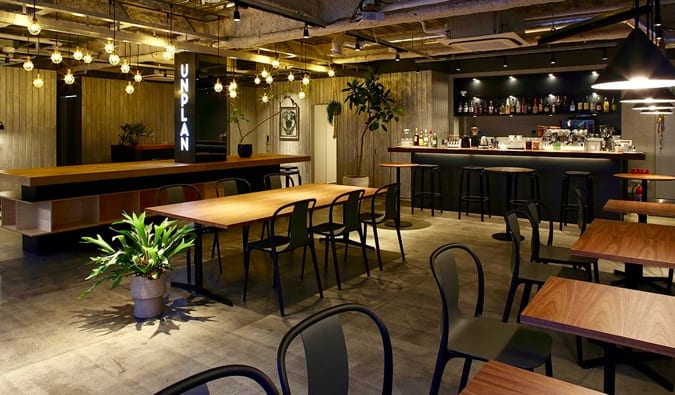
This hostel is only a few years old, so it’s still very clean and stylish, with wood floors and minimalist décor. Unplan has a variety of room styles, ranging from dorms to private rooms with four beds, making it a good fit for everyone from solo travelers to families. There’s a public café on the first floor that serves excellent coffee and turns into a bar at night, with plenty of sake and local beers to choose from.
Breakfast is free and hearty. You have to pay extra for the rentable pocket Wi-Fi (JP¥ 400/$4 USD), though. Unplan is a pricier hostel than most, but its location at the center of the city and its quality rooms make it worth it.
Beds from JP¥ 4,200/$38 USD, privates from JP¥ 18,500/$168 USD.
—> Book your stay at Unplan Kagurazaka
9. CITAN Hostel
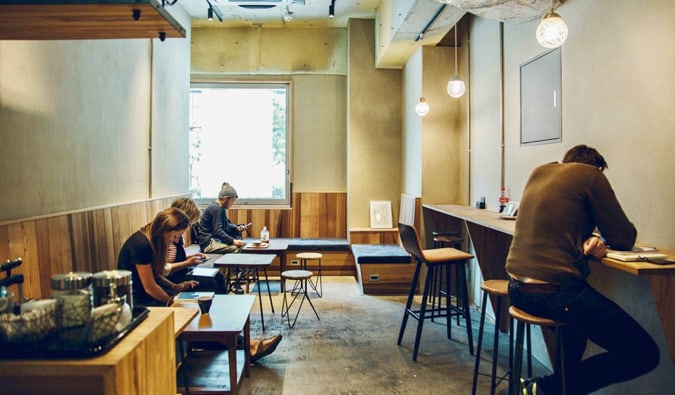
CITAN is a hipster paradise in the Nihonbashi area, and what I would call a “boutique” hostel. The building is seven stories, with 130 beds, everything is kept clean, and the showers have strong water pressure. The common area on the first floor is a relaxed hangout, and there’s a good kitchen for cooking.
There’s also an amazing coffee shop (Berth Coffee) on the first floor, and a bar and restaurant in the basement. This bar is packed on weekends, and not just with hostel guests; there is also usually a DJ on Saturday nights.
Because of this, it doesn’t have that much of a hostel vibe. But the neighborhood is peaceful, so you’ll get a good night’s sleep.
Beds from JP¥ 3,000/$27 USD, privates from JP¥ 9,000/$82 USD.
—> Book your stay at CITAN Hostel
10. Space Hostel Tokyo

This is a cozy, chill hostel in the Kitaueno area, close to the Skytree Tower and just a three-minute walk to the Iriya station. The rooms are super clean and the beds are comfy, with down quilts. I love the rooftop lounge, and there’s a small but decent kitchen and common area.
But the best thing about this hostel is its events: you can choose from sushi-making parties, calligraphy classes, origami experiences, and Japanese language lessons. Bring cash, as payment is due at check-in.
Beds from JP¥ 2,700/$25 USD, privates from JP¥ 13,200/$120 USD.
—> Book your stay at Space Hostel Tokyo
11. Book and Bed Tokyo

If you’re a book lover, you have to check this place out! This hostel is also a bookstore, where you sleep among the shelves. You can also read the books, magazines, and manga, many of which are in English. You can choose from a compact or standard bunk bed; each room has a shared en suite bathroom, and you’ll get free slippers.
As you can imagine, it’s a low-key place but a really unique experience! It’s also just a three-minute walk from Ikebukuro Station, which will take you just about anywhere you need to go.
Beds from JP¥ 3,800/$35 USD.
—> Book your stay at Book and Bed Tokyo
12. Hostel & Café East57

This little guesthouse is located in Asakusabashi, next to Asakusabashi Station and is a great value. There are lots of beds, so you can usually find a spot. There are several different types of rooms, including dorms, capsule spaces, family rooms, and private Japanese-style rooms. The biggest room has 21 beds, but privacy curtains separate each one.
This is also a newer hostel, so everything is in great condition and very clean. The Wi-Fi is strong, and there’s a fully equipped laundry room. Hang out at the café/bar area (with local beer on tap); it’s sociable and you will end up having great conversations with the staff.
Beds from JP¥ 2,200/$20 USD.
—> Book your stay at Hostel & Café East57
13. IRORI Hostel & Kitchen

This is a unique hostel located in Nihonbashi that focuses on the joy of cooking! There are a lot of shared kitchen spaces, and they are very well equipped. You can visit the market, bring your finds here, and make a delicious meal. And there are always other travelers around who are willing to help out, so you’ll likely find yourself in the middle of a communal meal.
They have an irori (a traditional Japanese fireplace), which you can cook in as well! You can pay JP¥ 500/$4.50 USD for a traditional Japanese breakfast of dried fish grilled over a charcoal fire in the irori, with rice, miso soup, and a side. The dorm beds have privacy curtains, making this a nice option for those who aren’t looking to party. If you’re wondering what to do in Nihonbashi, the staff has tons of great recommendations!
Beds from JP¥ 3,000/$27 USD.
—> Book your stay at IRORI Hostel & Kitchen
While Tokyo isn’t the most budget-friendly destination in the world, you can definitely save a lot of money by staying in these amazing hostels in Tokyo when you visit.
Book Your Trip to Japan: Logistical Tips and Tricks
Book Your Flight
Find a cheap flight by using Skyscanner or Momondo. They are my two favorite search engines because they search websites and airlines around the globe so you always know no stone is left unturned.
Book Your Accommodation
You can book your hostel with Hostelworld as they have the most comprehensive inventory so they are best for booking a hostel. If you want to stay in a hotel or guesthouse in Japan, use Booking.com as they consistently return the cheapest rates for guesthouses and cheap hotels. They’re the best booking site out there.
Don’t Forget Travel Insurance
Travel insurance will protect you against illness, injury, theft, and cancellations. It’s comprehensive protection in case anything goes wrong. I never go on a trip without it as I’ve had to use it many times in the past. I’ve been using World Nomads for ten years. My favorite companies that offer the best service and value are:
- World Nomads (for everyone below 70)
- Insure My Trip (for those over 70)
Looking for the best companies to save money with?
Check out my resource page for the best companies to use when you travel! I list all the ones I use to save money when I travel – and I think will help you too!
Looking for more travel tips for Japan
Check out my in-depth Japan travel guide for more ways to save money, costs, tips on what to see and do, suggested itineraries, reading, packing lists, and much, much more!
Photo credit: 2, 3, 4, 5, 6, 7, 8, 9, 10, 11, 12, 13, 14
The post The 13 Best Hostels in Tokyo appeared first on Nomadic Matt's Travel Site.



